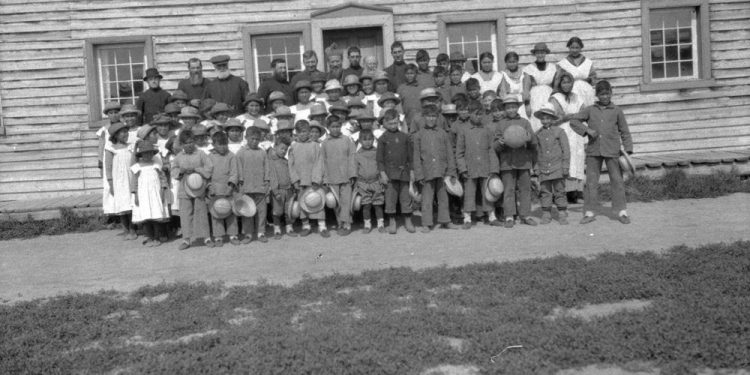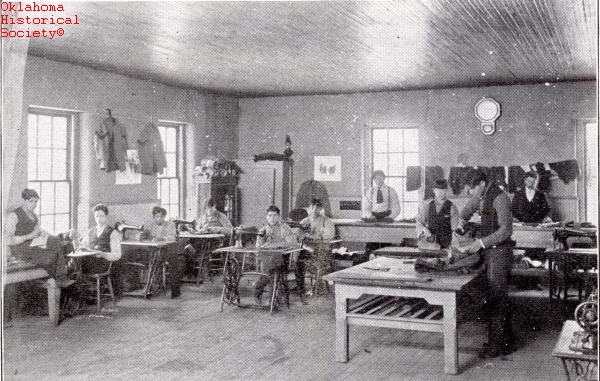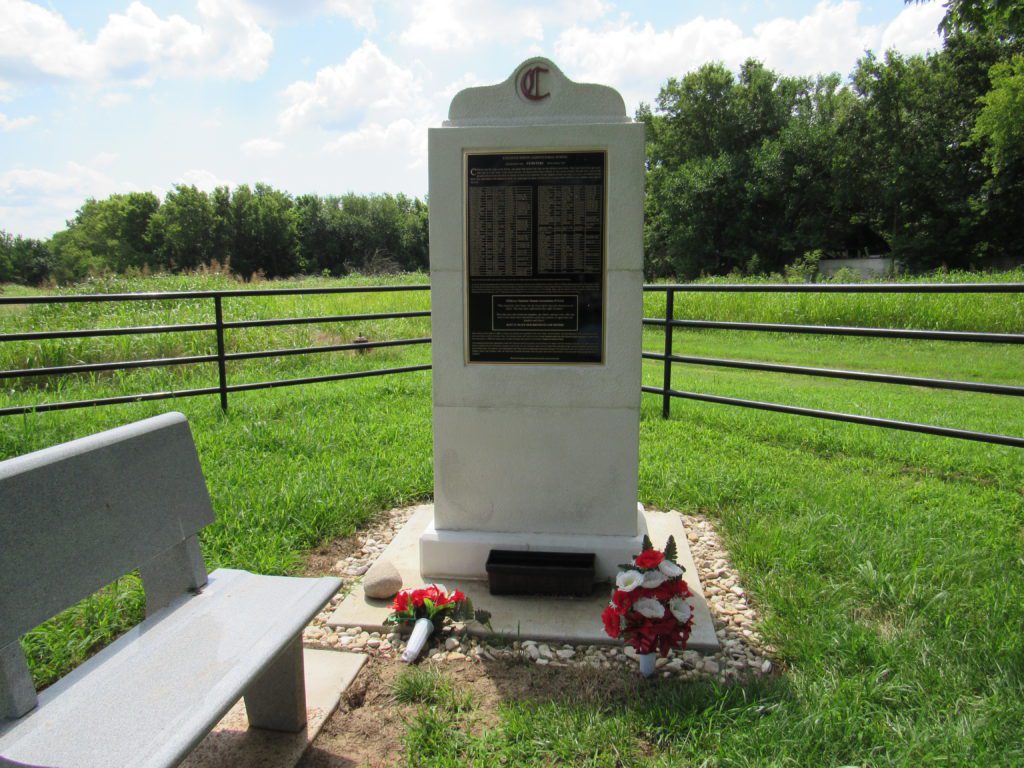On July 16, a brigade of cars and motorcycles crossed over the Missouri River via the Chief Standing Bear Bridge. Their arrival in South Dakota marked the conclusion of a three-day journey to return the remains of nine children to the Rosebud Sioux Indian Reservation more than 140 years after the children died at Carlisle Indian Industrial School in Carlisle, Pa.
The remains of a tenth child were returned to the Aleutian people in Alaska in June. During the 10 exhumations, a set of unidentified remains was also uncovered.
According to the Carlisle Indian School Digital Resource Center of nearby Dickinson College, there are known to be more than 180 graves at the Carlisle Indian School Cemetery. But as the Anchorage Daily News reports, “The true number may never be known, historians say, given poor record keeping, sloppy burial practices and the relocation in 1927 of a cemetery so that a parking lot could be constructed.” Some of the graves contain errors in both children’s names and their tribes.
These recent exhumations follow the discovery of hundreds of unmarked graves in residential schools in Canada in June.
For Indigenous communities, the existence of these schools and the abuse, neglect, and murder committed within them are not new; Indigenous communities have been aware of — and harmed by — boarding schools, many of them run by Christian groups, for generations. And though Indigenous people have ideas about how Christian communities can atone for their involvement in the schools, many are not sure Christians are willing to listen.
The Christian legacy
For Rev. Jim Bear Jacobs, a citizen of the Stockbridge-Munsee Mohican nation and co-director of racial justice for Minnesota Council of Churches, the fact that there’s a graveyard attached to any school is unconscionable.
“Christians sometimes want me to acknowledge the good intentions of the boarding schools at the time,” said Jacobs, whose great grandfather was taken to Carlisle. Jacobs finds such attitudes dismissive. “There’s a graveyard attached to a school. At what point does that become OK? They were forcibly taken from their families and they died. Regardless of what the cause of death was, their bodies were never returned to their families. These families are left devastated not knowing where their child is. There’s no justification of that at all.”
Opened in 1879, the Carlisle Indian Industrial School was the first boarding school in the United States that housed Indigenous children in an off-reservation setting, far from their homes. In 1891, the U.S. passed a compulsory attendance law that required Indigenous children to go to the schools. The Carlisle school eventually served as the blueprint for over 300 boarding schools for Indigenous children across the U.S. as well as a similar program in Canada
While the U.S. government opened 25 federal off-reservation boarding schools, more than 300 other schools were run by Christian groups with support from the government.
Upon arrival, the schools forced students to cut their long hair, a significant element of Indigenous faith and culture. The schools gave children English names and forbade them to speak their native language. In short, the church-run schools worked in cooperation with the government to strip the children of their spiritual and cultural practices and replace them with Christianity.
Some children were also exploited for free labor: They were sent to farm or perform housecleaning for local non-Natives. There are numerous reports of children at these schools being underfed, malnourished, and sick.
Dr. Tink Tinker, a citizen of the Osage nation and professor emeritus of American Indian cultures and religious traditions at Iliff School of Theology, said that people in the United States don’t want to know “that they killed Indians, cheated Indians, and stole land in order to create this romantic experiment called the United States.”
“Americans don’t want to know that children at boarding schools were fed a diet that put them at great risk of disease,” Tinker told Sojourners. “What the boarding schools demonstrate is that genocide was planned and supported by the state, that is the federal government of the United States.”
This is not news
While the existenece of Indigenous boarding schools has largely been erased from U.S. history, Indigenous people have been advocating for greater truth-telling for decades. And they hope change is coming.
On June 22, following the discovery of mass graves of Indigenous children at Canadian residential schools, Deb Haaland, the U.S. Secretary of the Interior, announced the creation of a Federal Indian Boarding School Initiative to conduct a comprehensive review of the troubled legacy of federal boarding school policies in the United States.
“The Interior Department will address the inter-generational impact of Indian boarding schools to shed light on the unspoken traumas of the past, no matter how hard it will be,” Haaland said to the National Congress of American Indians. “I know that this process will be long and difficult. I know that this process will be painful. It won’t undo the heartbreak and loss we feel. But only by acknowledging the past can we work toward a future that we’re all proud to embrace.” Haaland is a member of the Laguna Pueblo; her great-grandfather attended the Carlisle school.
Colette Yellow Robe, a citizen of the Northern Cheyenne, grew up knowing about boarding schools. Her mother survived boarding school and her grandfather attended and survived Carlisle. In April, she said at least one of her family members died under suspicious circumstances at a boarding school.
“We knew this was there, the cover-up of the death or murders,” Yellow Robe told Sojourners.
“When some of us went to high school, some went to the boarding schools that are still open. Or historically you just knew someone’s family who went to boarding school,” Yellow Robe said. “It’s common. It’s a part of everyday existence. It’s like driving by a national park: It’s just there.” Though attendance is no longer mandatory, the U.S. still runs several boarding schools for Indigenous children.
Ruth Hopkins, a Dakota and Lakota Sioux writer and former tribal judge, told Sojourners her father was abducted and taken to a boarding school when he was still nursing. “My whole life I've known about it. I’ve heard different things spoken about in hushed tones,” she said.
Hopkins said that the schools were forced upon Indigenous communities: families who refused to send their children to the schools could be denied treaty rations or sent to jail. In many cases, children were abducted from their homes by nuns and priests. To this day, Hopkins said, Indigenous people are wary of outsiders or white people on reservations.
“If they see outsiders coming, or white people coming, they don’t want them to be around their children or see their children. That’s from boarding schools, because they used to come and take peoples’ kids,” Hopkins said. One of her grandmothers used to hide one of her children every time a stranger came onto her property. The rest of her children were brought to boarding schools.
Now, the legacy of boarding schools affects everything from her community’s lack of knowledge of their native language to how Hopkins folds her towels: the way her father was taught at boarding school. It’s a legacy of trauma.
“You have all of these people who were put through extreme abuse and neglect,” Hopkins said. “You have people who didn’t really learn how to parent correctly. And they have all of these missing pieces in them from their culture and their language being taken away.”
Going forward
Indigenous people have suggestions for how, after centuries of abuse, Christians can begin to make restitution for these crimes.
The experts interviewed for this piece hope that Christians will advocate against pipelines, many of which directly violate treaty rights between the U.S. government and Indigenous communities.
As Tinker put it, Indigenous communities need non-Natives “to become allies in the Indian struggle for freedom” by physically standing up for Indigenous dignity, as some did at the Dakota Access Pipeline protest in 2016 and 2017. He implores Canada and the United States “to resist the military industrial complex and its fossil fuel subsidiary as they try to lay pipelines across Indian land or close enough to Indian land to threaten Indian water supply.”
Jacobs, who also serves as a parish associate at Church of All Nations Presbyterian Church in Columbia Heights, Minn., is calling for reparations for Indigenous people. He maintains that every predominantly white church in this country should have a line in their budget that is dedicated to local Indigenous language and cultural reclamation projects, “and it should be a significant amount of the annual budget.”
“It should be a significant amount because, for Indigenous people, the legacy of boarding schools is that it cost us everything,” Jacobs said. “We lost our language. We lost ties with our families and our culture. At a minimum, I tell churches that the work of repair looks like them paying a price to help try and mitigate and reverse some of the damage that came out of those boarding schools.”
However necessary, reparations and anti-fracking advocacy might be a big leap, especially for U.S. churches that have not claimed responsibility for the boarding schools or the murders of Indigenous children within them. The national Native American Boarding School Healing coalition lists 14 different religious groups that operated boarding schools in the United States, including Roman Catholics as well as Presbyterian, Quaker, Episcopal, Methodist, Baptist, Mennonite, and other Protestant denominations.
There’s some hope this is changing: While the Vatican has refused to release residential school records, two religious communities in Canada have released records as well as the United Church of Canada.
In December, the pope is scheduled to meet with representatives of Canada’s three biggest Indigenous groups — the First Nations, the Métis, and the Inuit — to “apologize for the church’s role in operating schools that abused and forcibly assimilated generations of Indigenous children.” A statement from the Canadian Conference of Catholic Bishops said that Pope Francis is “deeply committed to hearing directly from Indigenous Peoples, expressing his heartfelt closeness, addressing the impact of colonization and the role of the Church in the residential school system, in the hopes of responding to the suffering of Indigenous Peoples and the ongoing effects of intergenerational trauma.”
Christian organizations would do well to not only tell the truth about boarding schools but to release any information pertaining to them.
Amber Starks, an Afro-Indigenous activist who is a citizen of the Muscogee (Creek) Nation, said that acknowledgement looks like an honest verbal acknowledgement and concrete action, not a halfhearted committee or one-time donation.
“There’s a lot of talk about restitution, but it just doesn’t seem authentic,” Starks said. “It doesn’t seem like the church as an institution genuinely cares about the ongoing harm of its participation in colonialism, in imperialism, and in genocide. Since it doesn’t care about those things, it doesn’t care about the healing that has to go into that.”
For Native communities, it’s clear that Christians are both complicit in and beneficiaries of the legacy of U.S. boarding schools. Will Christians acknowledge this reality?
Starks hopes so.
“Be willing to be exposed for the wrong that you’ve done,” Starks said. “It shouldn’t take years to return the bodies of our relatives to tribes so that tribes can bury them in accordance with tradition and protocol. Where’s the humanity in that? Why would it take that long?”
“There are all of these lives buried underneath this place that you call holy ground,” she continued. “And it’s not holy. It’s been desecrated because you committed genocide.”







 “Our government stands shoulder to shoulder with Indigenous partners as we support community-directed work to identify and commemorate Indigenous Residential School sites across the province. Today’s investment in the Woodland Cultural Centre is critical to the important work being done by Six Nations of the Grand River to build a national resource to support public education and centre for healing for the community.” – The Honourable Greg Rickford, Ontario’s Minister of Indigenous Affairs
“Our government stands shoulder to shoulder with Indigenous partners as we support community-directed work to identify and commemorate Indigenous Residential School sites across the province. Today’s investment in the Woodland Cultural Centre is critical to the important work being done by Six Nations of the Grand River to build a national resource to support public education and centre for healing for the community.” – The Honourable Greg Rickford, Ontario’s Minister of Indigenous Affairs















